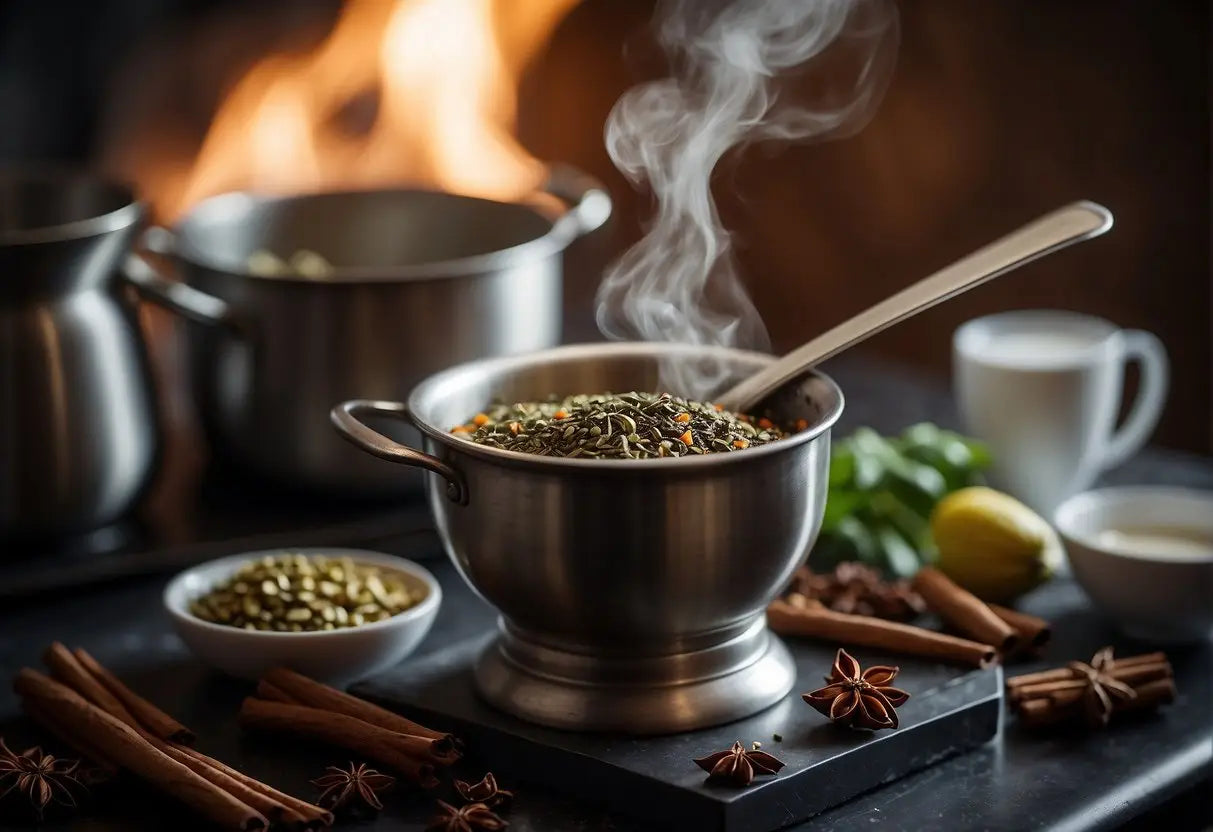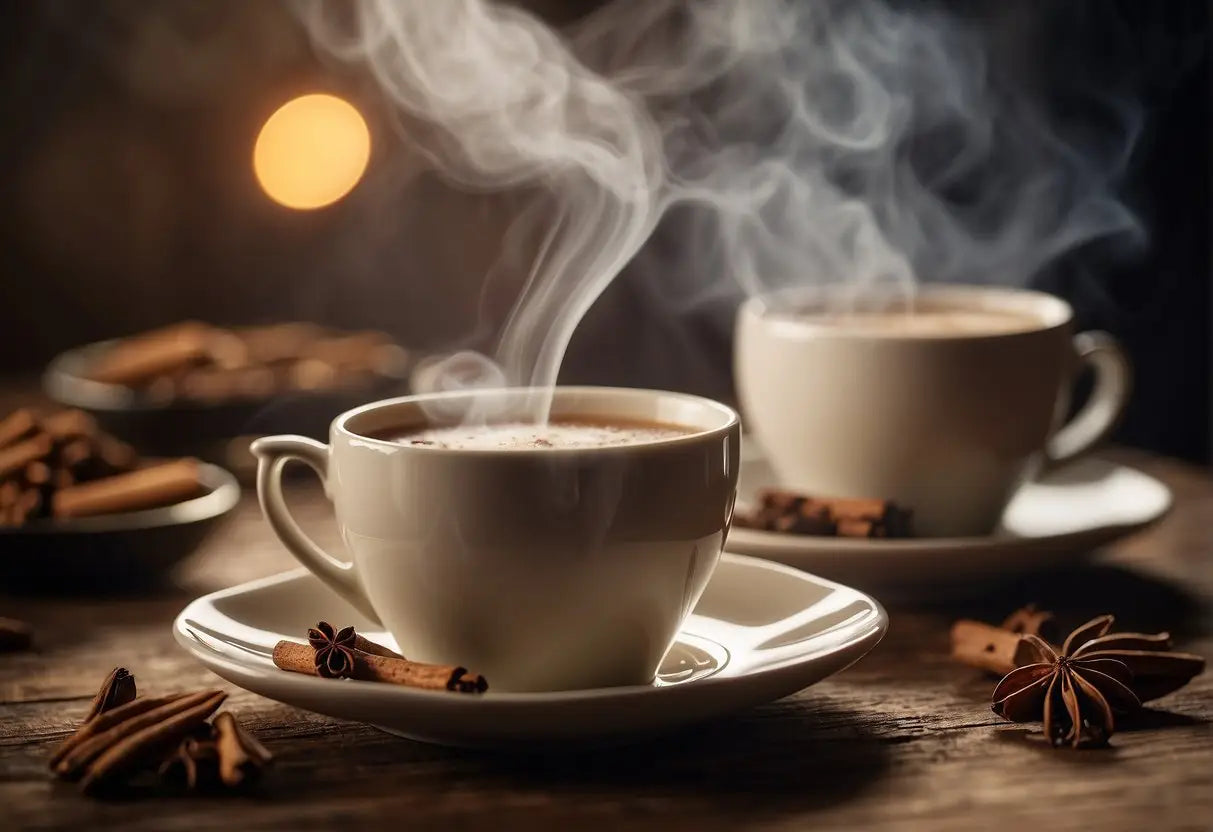What is Chai Tea
Chai tea is a rich and complex beverage that has gained worldwide popularity. Here, you'll learn about its essence, historical roots, and the role it plays in various cultures.
Definition
Chai tea is a flavored tea beverage made by brewing black tea with a mixture of aromatic spices and herbs. Its core components typically include cardamom, cinnamon, ginger, cloves, and black peppercorns. Milk and sugar are often added to enhance its taste and creaminess.
Origins and History
The origin of chai tea dates back over 5,000 years to ancient India. It began as an Ayurvedic tonic with various spices used for their health benefits. The version of chai tea you might be familiar with today, which includes black tea, became popular in the 1830s due to British influence and the promotion of black tea consumption in India.
Bestsellers
Cultural Significance
In many parts of the world, particularly in India, chai is more than just a cup of tea; it's a significant part of daily life. Chai is deeply woven into the social fabric, commonly enjoyed during breaks throughout the day and when hosting guests. Sharing a cup of chai is seen as a gesture of hospitality and warmth.
Ingredients and Preparation

Chai tea, a beverage with rich cultural heritage, primarily revolves around a blend of black tea, spices, milk, and sweeteners. Understanding the key ingredients and their roles is crucial for authentic preparation.
Key Ingredients
- Black Tea: Typically, Assam or Darjeeling tea is used for its strong flavor.
-
Spices: A traditional mix often includes:
- Cardamom: Adds a sweet and spicy note.
- Cinnamon: Provides warmth and sweetness.
- Ginger: Delivers a sharp and pungent taste.
- Cloves: Offers a potent, sweet, and bitter flavor.
- Black Peppercorns: Gives a subtle heat.
- Milk: Whole milk is preferred for its richness, but alternatives like soy or almond can be used.
- Sweetener: Sugar is common, though honey or other sweeteners can substitute.
Traditional Brewing Methods
To prepare traditional chai, you will:
- Crush the spices to release flavors.
- Boil water and add the crushed spices and black tea leaves.
- Allow the mixture to simmer and then add milk.
- Continue to simmer, then add sweetener to taste.
- Strain the chai into cups and serve hot.
Variations and Modern Takes
While traditional chai has a classic recipe, modern variations exist to cater to diverse palates. You might encounter:
| Variation | Description |
|---|---|
| Masala Chai | Includes a more complex spice mixture, sometimes incorporating fennel or star anise. |
| Chai Latte | Emphasizes the creaminess with steamed milk, often found in coffee shops. |
| Iced Chai | A chilled version of the tea, which may include fewer spices to suit a refreshing profile. |
These adaptations allow for personalized experiences while honoring the essence of chai tea.
Health Benefits and Nutritional Information
Chai tea is not only a warm, soothing beverage but can also offer several health benefits due to its blend of spices and tea leaves. Below, you will find detailed information about its potential health benefits, nutritional components, and common misconceptions.
Potential Health Benefits
Antioxidants: Chai tea contains high levels of antioxidants which can help protect your cells from oxidative stress.
- Cardiovascular Health: The black tea in chai is associated with improved heart health.
- Digestion: Ingredients like ginger and cardamom may aid in digestive health.
Nutritional Components
Calories and Macronutrients:
- An 8-ounce cup of unsweetened chai tea brewed with water has minimal calories and no significant macronutrients.
Vitamins and Minerals:
- Chai spices contain trace amounts of minerals such as potassium, calcium, and magnesium.
| Component | Amount* |
|---|---|
| Calories | < 5 |
| Total Fat | 0g |
| Sodium | < 5mg |
| Total Carbohydrates | 1g |
| Sugars | 0g |
| Protein | 0g |
| *Values are approximate and based on standard recipes without added sweeteners or milk. |
Common Misconceptions
Caffeine Content: You may think chai tea is caffeine-free, but it contains caffeine due to the black tea leaves.
- Sugar Content: While chai tea itself is low in sugar, commercially prepared mixes and those served at coffee shops are often high in sugars and calories.
Serving and Consumption

Lao Ban Zhang
When enjoying chai tea, the method of serving and the accompaniments chosen are as important as the tea itself. Here, we explore traditional ways to enjoy chai, typical pairings, and the cultural nuances of consuming this spiced beverage.
Traditional Serving Styles
In India, chai is typically brewed with strong black tea, a mixture of spices such as cardamom, cinnamon, ginger, and clove, and is simmered with milk and sweetened with sugar. It is common to find chai wallahs serving this concoction in small, unglazed clay cups called kulhads, which are said to add an earthy flavor to the tea.
In Western countries, chai tea often comes as a pre-spiced powder or concentrate that is mixed with hot milk or water. It's served in mugs and is sometimes topped with whipped cream or a sprinkle of spice for a latte-style preparation.
Accompaniments and Pairings
Chai tea pairs well with a variety of foods. Consider the following:
-
Sweet treats:
- Biscuits
- Pastries
- Chocolate
-
Savory snacks:
- Samosas
- Pakoras
- Sandwiches
The warmth of chai spices complements sweet items by balancing the richness, while with savory snacks, it acts as a soothing counterpoint to any heat or strong flavors.
Etiquette and Consumption Practices
The consumption of chai tea comes with its own set of etiquette practices, many of which are culturally specific. In India, it's polite to receive your chai with both hands and take small sips to savor the flavor. Drinking chai is often a social event, with people gathering around the chai wallah or in someone's home, sharing their day's stories.
In Western contexts, chai is more individualistic. You might enjoy a chai latte on the go, using a takeaway cup with a sip lid. Regardless of the setting, take a moment to taste the complex interplay of flavors in each sip.
Chai Tea in the Global Market

Chai tea has emerged as a significant contender in the beverage industry, with its demand and impact growing globally.
Popularity and Trends
Globally, chai tea has seen a steady increase in popularity, particularly noted in the rise of specialty chai blends and chai-related products. North America and Europe have seen pronounced growth, with chai latte variations becoming mainstays in coffeehouses. Data from market analyses show a compound annual growth rate (CAGR) of approximately 5-7% over the past five years in these regions.
- Specialty chai tea shops and chains are expanding.
- Online sales of chai products have surged, reflecting a broader trend in e-commerce for food and beverages.
Commercial Availability
Chai tea has become widely available, with numerous brands and forms present in both physical retailers and online platforms. Your shopping options include:
- Loose-leaf blends: Traditional and artisanal, found in specialty stores.
- Tea bags: Convenient and accessible in supermarkets.
- Instant powders: Quick preparation, popular in mass-market retailers.
- Ready-to-drink bottles: Seen in convenience stores and vending machines.
The competition among brands is intense, leading to more options for you in terms of flavors, price points, and quality.
Influence on Other Beverages
Chai-inspired flavors have extended to a range of different beverage categories, influencing new product developments. For example, Chai-flavored syrups are used in a variety of drinks, not just traditional teas. You can find chai flavors in:
- Coffee-based drinks: Lattes, cappuccinos, and cold brews.
- Non-dairy milk alternatives: Almond, soy, and oat milk products featuring chai spices.
- Alcohol: Craft beers and liqueurs incorporating chai profiles.
Frequently Asked Questions

In this section, you'll find answers to common queries about chai tea, from its health benefits to its preparation and ingredients.
What are the health benefits of drinking chai tea?
Chai tea is often associated with various health benefits due to its blend of spices and tea. These ingredients can offer antioxidant properties and may aid in digestion, reduce inflammation, and enhance immune function.
How is a chai tea latte prepared?
To prepare a chai tea latte, steep a chai tea blend in hot water, then mix in steamed milk to create a frothy and creamy beverage. It's typically sweetened with sugar or honey to taste.
What ingredients are used to make chai tea?
Chai tea is traditionally made with black tea and a mixture of aromatic spices like cardamom, cinnamon, ginger, cloves, and black pepper. Each recipe can vary with the addition of spices like nutmeg or fennel.
Can chai tea contribute to better health?
Regular consumption of chai tea may contribute to better health by providing you with antioxidants from both tea and spices, which might help in protecting your cells from damage by free radicals.
How much caffeine is typically found in a cup of chai tea?
A standard cup of chai tea contains approximately 25-50 mg of caffeine, but this can vary based on the type of black tea used and the brewing time.
What distinguishes chai tea from regular tea?
Chai tea differs from regular tea primarily because of the addition of spices. While regular tea typically only includes the tea leaves, chai tea blends those leaves with a variety of spices that give it a unique flavor and potential health benefits.
← Older post Newer post →











